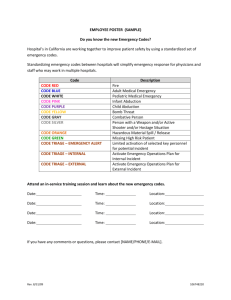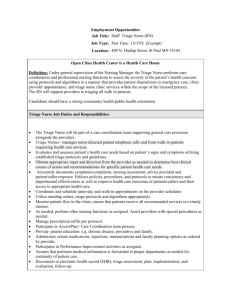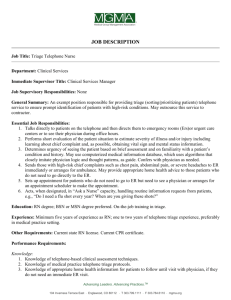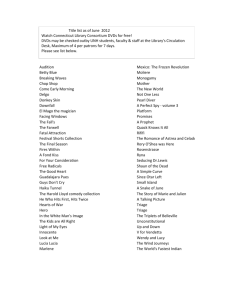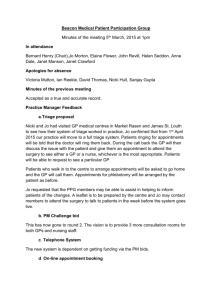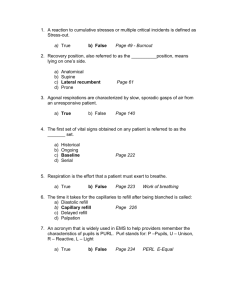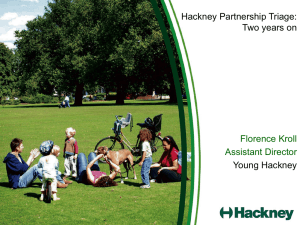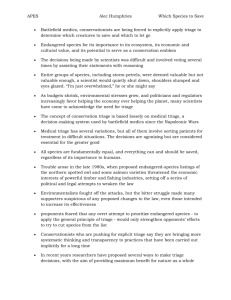Effective Nursing Triage
advertisement
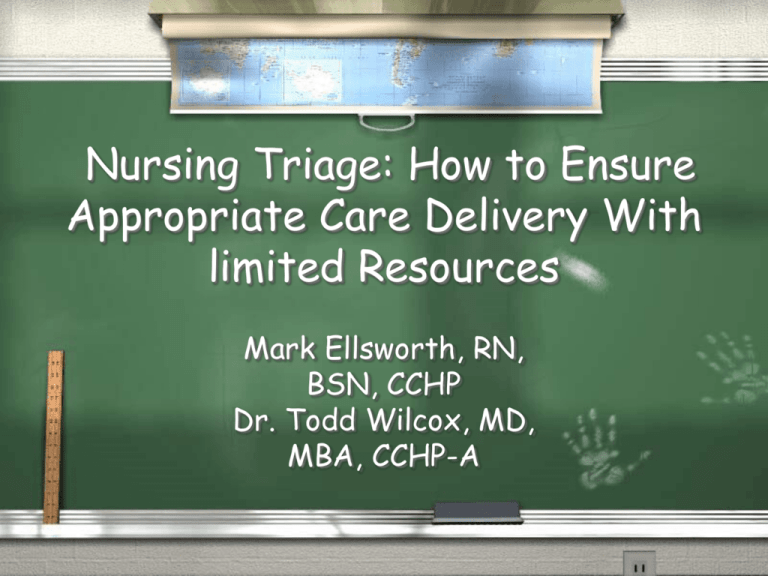
Nursing Triage: How to Ensure Appropriate Care Delivery With limited Resources Mark Ellsworth, RN, BSN, CCHP Dr. Todd Wilcox, MD, MBA, CCHP-A “Learning Experiences” Prisoner submits a Sick call request for low back pain. Seen by provider, diagnosed with chronic low back pain, given Tylenol. 2 weeks later, Patient complains of increased back pain, submits new kite every day for a week. Never seen in person, the paper triage disposition is “you have already been seen for this” Patient becomes a man-down, sent to ER where he is diagnosed with an acute abdominal aneurysm and died. The Problem Clinical mistakes being made under old system Scheduling issues Doctors frustrated Nurses frustrated Officers frustrated Patients frustrated Litigation exposure The Solution Redesign triage Train up nurses to standardize skill set and knowledge base Create an on-site nursing program Physicians teach the curriculum Skills pass off CQI to revise curriculum and address problems Definition of Triage “To sort” “Sorting of patients and setting priorities for their treatment in urgent care settings, emergency rooms, clinics, hospitals, and health maintenance organizations.” Tabors Cyclopedic Medical Dictionary, 2001 Purpose of Triage Determines severity of prisoner’s current chief complaint Helps allocate limited resources in most effective manner Assists in preventing the system from becoming overwhelmed Spot Checking-Mass Casualty Model Gravely injured Moderately injured Minor Injury Traffic Director- Physician Office Model A non clinical employee schedules the patient, can be moved up in priority based on “impressions” Comprehensive Triage-Emergency Severity Index Model Based on 5 levels of Acuity An experienced nurse completes a comprehensive assessment Adopted by most hospital ER’s Clinical Case Prisoner submits sick call request for leg and back pain. Paper triage done, patient never evaluated, triage given a “routine” appointment which meant 3 week wait. Prisoner begged housing nurse and officers to have him seen, they responded with “submit a sick call”. Prisoner collapsed 2 days later, found to have totally necrotic leg from necrotizing fasciitis. Sent to ER, prisoner underwent a hemipelvectomy, ended up in hospital for a long time, huge bills, ultimately died, family sued for deliberate indifference , won several million dollars. Keys to Performing Triage Experienced Nurses Encourage intuitive skills Empower Nurses to use the skills they have been taught Support Nursing with appropriate ancillary staff, you will loose the efficiencies of your nurses if you turn them into HUC’s Triage Algorithm Requires immediate life-saving int ervention or high risk sit uations Yes 1 No T he patient is stable but could det eriorate if t reatment is delayed Yes No 2 evaluat e need for differential t est ing none one 4 3 many danger zone vit als? HR >100 RR >20 SaO2<92% No 3 Consider Building a 5 Tier System Level 1=Resucitation or life or limb conditions, that demand care immediately. Examples: Apnea or severe respiratory distress. Pale, diaphoretic and lightheaded or weak, hypotension. Building a 5 Tier System Level 2=High risk situations that will deteriorate if left untreated. Examples: At risk vital signs, severe pain, lacerations, recent injury and pain increases with movement Building a 5 Tier System Level 3= Stable patient, chief complaint does not fall into nursing’s ability to care for with a nursing intervention, and is not in queue for a clinician follow up. Building a 5 Tier System Level 4= Stable patient who will need multiple resources prior to appointment. These can be administrative or diagnostic in nature. Building a 5 Tier System Level 5= Nursing interventions. Chief complaint can be treated by implementing a nursing care plan or a verbal order by a clinician. Content of a good assessment Talk with each and every inmate who has a completed sick call request (kites). Face-to-face contact--Illogical and improper to base your healthcare delivery system on the written skills of a 4th grader (AT BEST) describing their problem Obtain complete vital signs--all 5!!! Focus assessment on chief complaint Assign a priority for provider scheduling Triage cannot be re-prioritized unless prisoner is seen face-to-face “Protocols” Nurses can implement nursing interventions Cannot Diagnose or implement medication without order of clinician Contact clinician for questions or orders The Keys to Performance Front load completion of resources. Resources=labs, x-rays, ECG, serial vital signs, signed consents for medical records Clinicians and nurses don’t always agree on the triage priority. Evolving process Dynamic Continual refinement, quality feedback and education is essential for ALL professionals involved Dental Triage Level 1 Some abscesses can fall into this category so it is advisable to call Dental Triage Level 2 Trauma with symptoms Tooth decay with severe symptoms Wisdom teeth with severe pain and swelling Visible facial swelling Dental Triage Level 3 Trauma without symptoms Bleeding gingiva with pus or necrosis Tooth decay with symptoms Loose tooth with pus or gingival swelling Wisdom teeth Ulcerative lesion Sessile lesions Dental Triage Level 4 Bleeding gingiva Tooth decay without symptoms Loose tooth without symptoms Mental Health Level 1 Suicidal ideation Threat of harm to others damage to facility Mental Health Level 2 Psychosis unable to perform ADL’s Mental Health Level 3 New mental health chief complaint Patients in treatment with changes in symptoms Mental Health Level 4 Administrative issues Medication management Avoiding Pitfalls Must see the patient in person Read the sick call request Verify the history Obtain complete set of vital signs, assessment Assign triage grade Research the chart for additional information Document your care focused Avoiding Pitfalls It is imperative that you see & talk with the inmate It is imperative that a complete set of vital signs be documented There is no right or wrong answer Prioritize scheduling to the best of your ability Practice brings confidence, confidence brings refined skills Slides available at www.wellcon.net Resources Emergency severity index;www.ahrq.gov/research Emergency Nursing 5-Tier Triage Protocols, J.K.Biggs, V.G.A. Grossman

